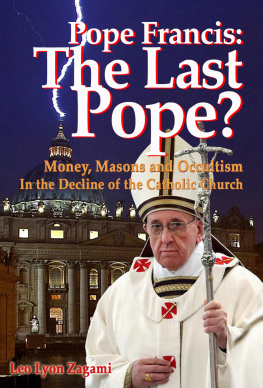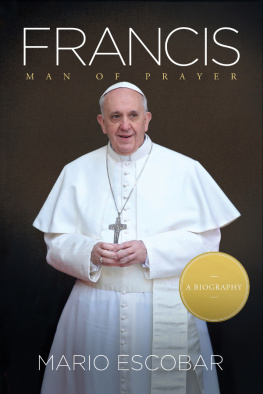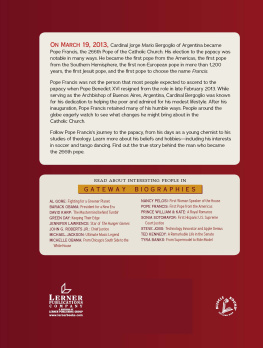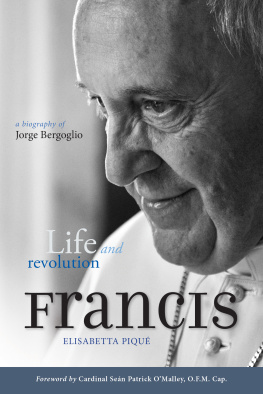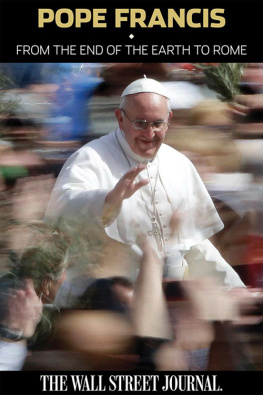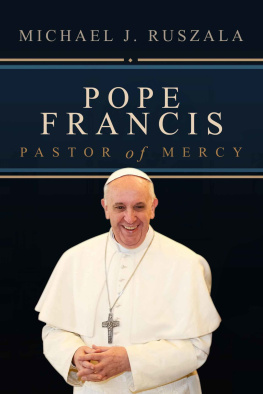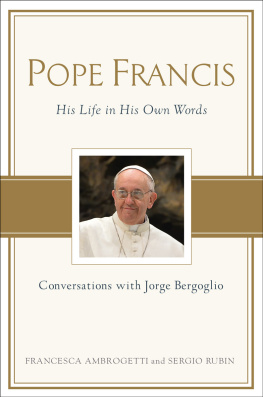FRANCIS,
BISHOP OF ROME
Michael Collins
Francis, Bishop of Rome
A SHORT BIOGRAPHY
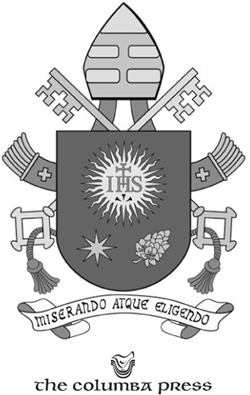
Published in 2013 by

55A Spruce Avenue,
Stillorgan Industrial Park,
Blackrock, Co. Dublin
Cover by Patrick ODonoghue
Cover image courtesy of LOsservatore Romano
Origination by The Columba Press
Printed in Ireland by SPRINT-print Ltd
ISBN 9781 78218 066 1
Copyright 2013, Michael Collins
EARLY LIFE

In September 1929 the twenty-one-year-old Mario Jos Bergoglio, father of the future pope, embarked on a ship in the Italian port of Genoa. The vessel, the Giulio Caesare, was bound for South America. For the young man, the journey offered the exciting prospect of starting a new life and perhaps a family in the New World.
With his father and mother, Giovanni and Rosa, the young man had travelled to Argentina slightly later than planned. Originally the family had intended to sail some years earlier on the Principessa Mafalda. The vessels voyage ended in disaster when the ocean liner was shipwrecked off the coast of Brazil, a tragedy in which hundreds of passengers were drowned. The Bergoglios delay in travelling had doubtlessly saved their lives.
Argentina had become a welcoming haven for thousands of European emigrants who made their home in the southern climes. Article 25 of the 1853 Constitution stated that:
The Federal Government will encourage European immigration, and it will not restrict, limit or burden with any taxes the entrance into Argentine territory of foreigners who come with the goal of working the land, improving the industries and teaching the sciences and the arts.
Between 1914 to 1947, the population of Argentina rose from 7.9 million to 15.8 million. The two largest blocks of settlers came from Spain and Italy. By 1947, 1.4 million Italians had settled in Argentina in the hope of finding prosperity and civil stability. That number had increased dramatically during and following the Second World War.
The attractive prospect offered by Argentina was all the more appealing to the Bergoglio family. For years they had watched the rise of Fascism in Italy. The fascist party, the Blackshirts, were founded in 1919 by a right-wing soldier, Benito Mussolini. By mid-1922, the party had amassed considerable political support and was about to seize power in Italy. The Bergoglios did not support the party or its divisive politics. Along with many other Italians, the Bergoglio family believed that only by leaving their homeland could they save their traditions and values.
The Bergoglios had left Portacomaro, a small town in the province of Asti, some 48 kilometres from Turin. For generations the family had lived at Bricco Marmorito, a few kilometres from Asti. The portal of the door of the ancestral home still bears a ceramic tile which reads Signore, benedici chi entra in questa casa (Lord, bless whomsoever enters this house).
The homestead, along with land and a small vineyard, was bought by four Bergoglio brothers in 1854 from a Jewish vendor. Over the years the family had expanded. Some worked the land while others were engaged in commerce in the town.
In the early 20th century, the family established a small confectioners shop. When various members of the family decided to emigrate, the decision was taken to sell the shop and house and join their relatives in their new homeland.
On 15 February 1930, the ship, the Giulio Caesare landed in Buenos Aires, at the end of a six-month voyage. After some calls at the ports of Europe, the ship had undertaken the long journey to the Americas. Despite the warm weather in Buenos Aires, Rosa Bergoglio wore a coat with a fur collar. Inside the lining of the collar were stitched Italian lire, the result of the sale of their property, which she had smuggled out of Italy. Passing unnoticed through the Customs office, the family descended the gangway onto the large square in front of the dockyard. The money in Rosas collar would be enough to make a new start in Argentina.
South America would be their homeland for the rest of their lives. Work was plentiful, civil strife was rare and social prospects were good. Moreover, three grand-uncles of the future pope had emigrated to Parana in 1922, where they had set up a small paving company. The area was thriving and construction opportunities were plentiful.
Unlike most migrants arriving in Buenos Aires, the Bergoglios did not need to stay in the hostel for migrants or register for work. With family connections, they could settle immediately into their new surroundings.
Welcomed at the dock by their relatives, the Bergoglios were escorted to the family home at Flores. This was a district close to the city centre, favoured by Italian migrants. The Italian population was so dense that most elderly Italians spoke their native dialect rather than learn Spanish.
With the arrival of Giovanni, four of the brothers now lived in Argentina; one brother and a sister remained in Italy. The Bergoglio family in Buenos Aires was expanding. The brothers had built a house on four floors thanks to the success of their construction enterprise. Each brother occupied a floor, leaving the ground level to be shared in common by family members, visitors and neighbours. The floors were reached by an elevator, the first to be built in the city of Buenos Aires. There was also a small cupola on the roof. The new arrivals settled in well. The climate was agreeable and the people welcoming.
Within three years of the Bergoglio familys arrival, however, Argentina experienced a dramatic financial crisis. In 1932 the building trade collapsed, and the Bergoglios were obliged to sell the house in which they lived. Even the family tomb had to be sold. One of the three brothers, the head of the paving firm, had died from cancer and another brother borrowed 2,000 pesos in order to buy a store and some stock. Mario had trained in Italy as an accountant and although his degree was not recognised in Argentina, he helped in the running of the new business with his accountancy skills. Through hard work and determination, the brothers managed to survive the crisis, although they were unable to revive the family fortunes entirely. Nonetheless, they had work, and once more were stable.
In 1934, Mario met a young Argentinian woman, Regina Mara Sivori. Her mother was of Genoese and Piedmont origin, while her father was Argentinian, descended from Genoese stock. The couple met at a social function in the parish of San Antonio in Almagro. The following year, on 12 December 1935, they were married in the local church. The newly-weds bought a house in the district of Flores to remain close to their families; number 500 calle Membrillar, close to Plaza de la Misericordia. The house was small, with a large kitchen and hearth. In this home the couples five children were to be reared.
On 17 December 1936, Regina Mara gave birth to her firstborn. He was called Jorge, a name frequently used within the family. It was the fourth centenary since the foundation of Buenos Aires. A week later, on Christmas Day, the infant was baptised in the Basilica of San Carlos Borromeo by the Salesian priest, Father Enrique Pozzoli. This priest was to have a great influence on young Jorge and he later became the youths spiritual director. The infants godparents were Francisco Sivori and Rosa Vassallo de Bergoglio.
The church, a magnificent neo-Gothic building, was to play an important role in the development of the young man. Here he served Mass and took part in the many annual feast days and processions popular among the Italian community. The great songwriter, actor and proponent of the tango, Carlos Gardel sang in the choir as a youth. Another notable past-member of the parish choir was the native Indian of Patagonia, Blessed Ceferino Namuncur, a Salesian seminarian who died in 1905. The parish contained a large number of migrants from Turin, a city important in the life of St John Bosco, founder of the Salesian Order.
Next page

